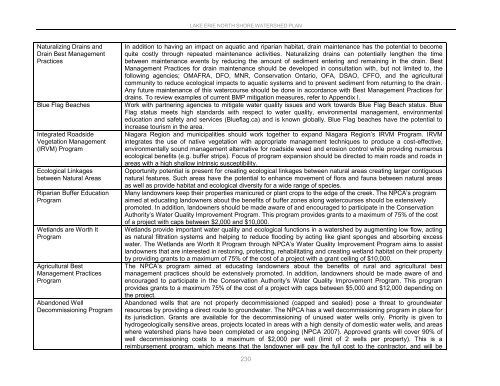Lake Erie North Shore Watershed Plan - Niagara Peninsula ...
Lake Erie North Shore Watershed Plan - Niagara Peninsula ...
Lake Erie North Shore Watershed Plan - Niagara Peninsula ...
You also want an ePaper? Increase the reach of your titles
YUMPU automatically turns print PDFs into web optimized ePapers that Google loves.
LAKE ERIE NORTH SHORE WATERSHED PLAN<br />
Naturalizing Drains and<br />
Drain Best Management<br />
Practices<br />
Blue Flag Beaches<br />
Integrated Roadside<br />
Vegetation Management<br />
(IRVM) Program<br />
Ecological Linkages<br />
between Natural Areas<br />
Riparian Buffer Education<br />
Program<br />
Wetlands are Worth It<br />
Program<br />
Agricultural Best<br />
Management Practices<br />
Program<br />
Abandoned Well<br />
Decommissioning Program<br />
In addition to having an impact on aquatic and riparian habitat, drain maintenance has the potential to become<br />
quite costly through repeated maintenance activities. Naturalizing drains can potentially lengthen the time<br />
between maintenance events by reducing the amount of sediment entering and remaining in the drain. Best<br />
Management Practices for drain maintenance should be developed in consultation with, but not limited to, the<br />
following agencies; OMAFRA, DFO, MNR, Conservation Ontario, OFA, DSAO, CFFO, and the agricultural<br />
community to reduce ecological impacts to aquatic systems and to prevent sediment from returning to the drain.<br />
Any future maintenance of this watercourse should be done in accordance with Best Management Practices for<br />
drains. To review examples of current BMP mitigation measures, refer to Appendix I.<br />
Work with partnering agencies to mitigate water quality issues and work towards Blue Flag Beach status. Blue<br />
Flag status meets high standards with respect to water quality, environmental management, environmental<br />
education and safety and services (Blueflag.ca) and is known globally. Blue Flag beaches have the potential to<br />
increase tourism in the area.<br />
<strong>Niagara</strong> Region and municipalities should work together to expand <strong>Niagara</strong> Region‟s IRVM Program. IRVM<br />
integrates the use of native vegetation with appropriate management techniques to produce a cost-effective,<br />
environmentally sound management alternative for roadside weed and erosion control while providing numerous<br />
ecological benefits (e.g. buffer strips). Focus of program expansion should be directed to main roads and roads in<br />
areas with a high shallow intrinsic susceptibility.<br />
Opportunity potential is present for creating ecological linkages between natural areas creating larger contiguous<br />
natural features. Such areas have the potential to enhance movement of flora and fauna between natural areas<br />
as well as provide habitat and ecological diversity for a wide range of species.<br />
Many landowners keep their properties manicured or plant crops to the edge of the creek. The NPCA‟s program<br />
aimed at educating landowners about the benefits of buffer zones along watercourses should be extensively<br />
promoted. In addition, landowners should be made aware of and encouraged to participate in the Conservation<br />
Authority‟s Water Quality Improvement Program. This program provides grants to a maximum of 75% of the cost<br />
of a project with caps between $2,000 and $10,000.<br />
Wetlands provide important water quality and ecological functions in a watershed by augmenting low flow, acting<br />
as natural filtration systems and helping to reduce flooding by acting like giant sponges and absorbing excess<br />
water. The Wetlands are Worth It Program through NPCA‟s Water Quality Improvement Program aims to assist<br />
landowners that are interested in restoring, protecting, rehabilitating and creating wetland habitat on their property<br />
by providing grants to a maximum of 75% of the cost of a project with a grant ceiling of $10,000.<br />
The NPCA‟s program aimed at educating landowners about the benefits of rural and agricultural best<br />
management practices should be extensively promoted. In addition, landowners should be made aware of and<br />
encouraged to participate in the Conservation Authority‟s Water Quality Improvement Program. This program<br />
provides grants to a maximum 75% of the cost of a project with caps between $5,000 and $12,000 depending on<br />
the project.<br />
Abandoned wells that are not properly decommissioned (capped and sealed) pose a threat to groundwater<br />
resources by providing a direct route to groundwater. The NPCA has a well decommissioning program in place for<br />
its jurisdiction. Grants are available for the decommissioning of unused water wells only. Priority is given to<br />
hydrogeologically sensitive areas, projects located in areas with a high density of domestic water wells, and areas<br />
where watershed plans have been completed or are ongoing (NPCA 2007). Approved grants will cover 90% of<br />
well decommissioning costs to a maximum of $2,000 per well (limit of 2 wells per property). This is a<br />
reimbursement program, which means that the landowner will pay the full cost to the contractor, and will be<br />
230
















